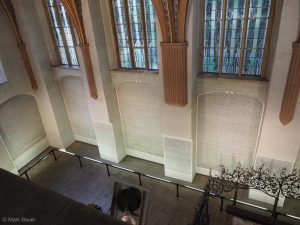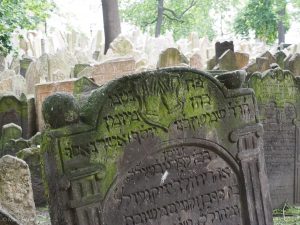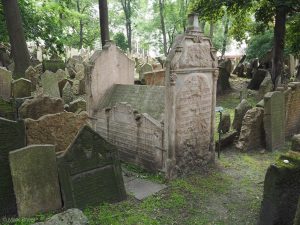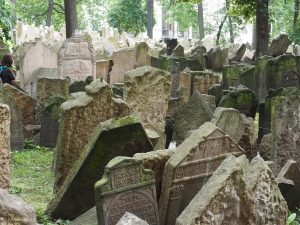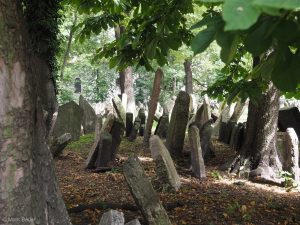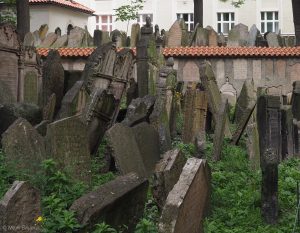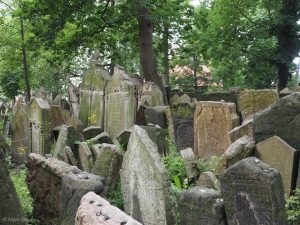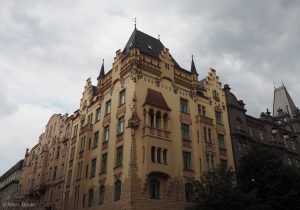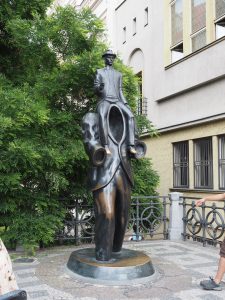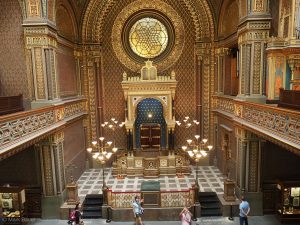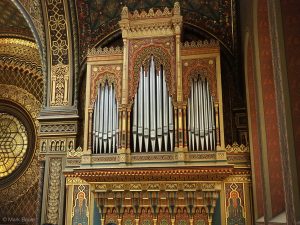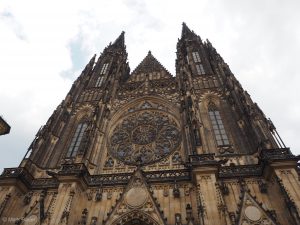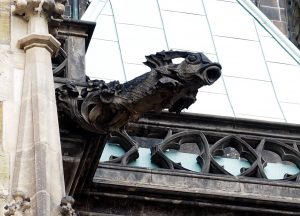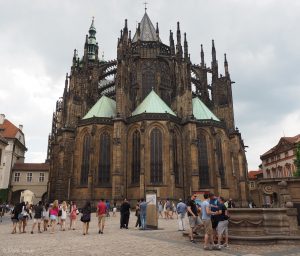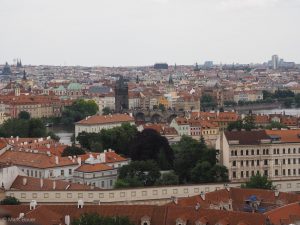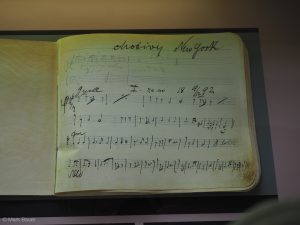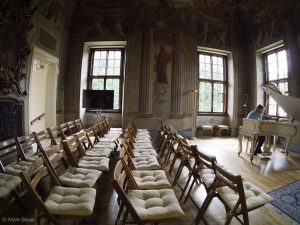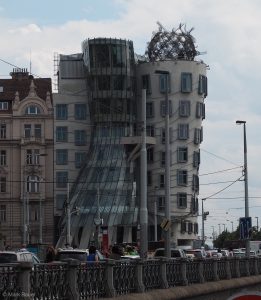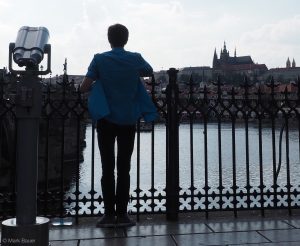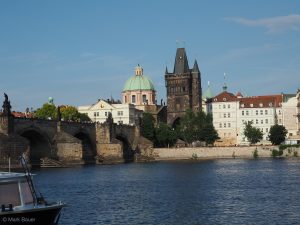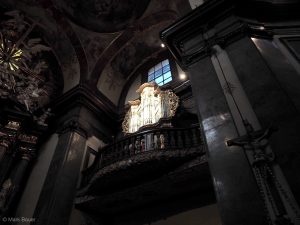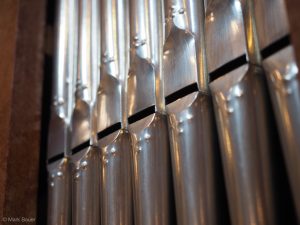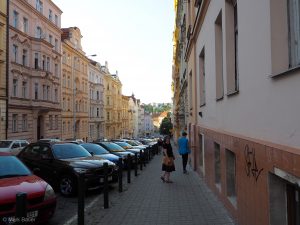Synagogue with names of murdered Jews from Prague and Bohemia
The Old Jewish Cemetery I (Cohen hands)
The Old Jewish Cemetery II ( tumba)
The Old Jewish Cemetery III
The Old Jewish Cemetery IV
The Old Jewish Cemetery V
The Old Jewish Cemetery VI
Another gorgeous Art Deco building, in the Jewish quarter
Kafka monument (Kafka on a headless man’s shoulders)
The Spanish Synagogue — Interior
The Spanish Synagogue — Organ
St. Vitus Cathedral (part of Prague Castle)
St. Vitus Cathedral — Fish Gargoyle
St. Vitus with plaza
Skyline of Prague from Prague Castle
Dvorak Museum — Dvorak’s New York notebook
Dvorak Museum — Piano tuning
The Dancing House (architects: Gehry & Milunič)
Kai and the Prague Castle
Charles Bridge
Organ in the Church of St. Francis (with the sun shining on the pipes)
Detail on small organ at St. Francis
In our hostel’s neighborhood
Given that we really only had this one full day in Prague, this day was pretty much perfect for the purpose. It was mostly sunny but not hot (70s), we found everything we were looking for, and we had a great if packed 10 or so hours! Mark and I woke up about 7, woke Kai so he could get ready, and left him to his own devices to go in search for a little coffee shop. We found a bakery with a couple of tables and had coffee, tea, and a couple of yummy things obtained by pointing and gesturing. Then we got another yummy thing for Kai (basically a piece of fluffy coffee cake) and brought it back to him along with some “coffee to go”–an institution in Prague as well Asian German cities that did not use to exist in my European days. Once Kai was ready, we embarked on our adventure and took the tram back towards downtown, getting off near the Charles Bridge again.
Our first destination was the Jewish quarter, where we looked at several synagogues and the Old Jewish Cemetery, the famous one that was in use a until the 18th century and has gravestones stacked everywhere. The earliest are from the 15th century, and in some sections, the ground is several feet higher than elsewhere because of up to 12 layers of burials (the stone slabs were moved up, but the bodies cannot be disturbed). We learned a lot–we cannot read the Hebrew inscriptions, but we saw the blessing hands that indicate the Cohen family tree (priests), and some graves had explanations, for example that of Rabbi Loew, who is associated with the legend of the golem as the protector of the Jewish ghetto of Prague. Many people leave pebbles on the gravestones, and Kai knew that this is a bit like leaving flowers in Christian cemeteries. The cemetery was not only a must-see and incredibly beautiful, but it had the additional frisson for me that George Eliot and George Henry Lewes visited it too, at least twice. Of course, at that time, the area would have been the Jewish district with its little crooked alleys and its many, many synagogues, but that was torn down in the late 19th and early 20th centuries to be replaced by lavishly decorated turns-of-the-century residences, five to six stories high. Of the synagogues, five are left, and we toured all but the Old-New Synagogue. One is a memorial to all the Jewish people of Prague and Bohemia who were killed by the Nazis, with all their names on the synagogue walls. One explained Jewish religious and secular life. One documented early Jewish life in Bohemia from the 10th to the 18th century, and the most beautiful, the Spanish synagogue, documented the 19th and 20th centuries. That meant that I was able to look at a few documents related to Leopold Kompert, the author I recently researched, and to his stories of life in the ghetto under Austro-Hungarian rule before emancipation in the 1860s. And there was documentation about the deportation of Prague’s Jews to Terezin, or Theresienstadt as I know it, after the Nazi occupation of Czechoslovakia. There were also a few Kafka mentions, plus a Kafka statue in front of the synagogue, but we would have had to go to the Kafka museum to find more–something we opted not to do. Instead, we roamed the streets a bit more and found our way back to the Old Town Square and then to a Czech restaurant with a basement level and mostly Czech guests. Again, we took a few guesses on the lunch menu, and what we ordered was ok, but still fundamentally the same salty-meat + dumplings + very cooked cabbage (plus bread, plus potatoes) fare as yesterday. I think we’re sort of past the kind of cuisine where the one raw vegetable to be had is onion. But it was cheaper than yesterday and we felt ready for more exploration.
So we took the tram across the river and up the hills on the other side to a station above the castle, and then walked down toward it. That was really beautiful, and the way to the castle, the elaborate multiple-castle complex, and the Gothic cathedral (St. Vitus) were really impressive, as was the view of the east side of the river (where we’d been in the morning). Since part of the building is still the residence of the Czech president and also an official government complex, we even saw a cadre of limos bring a bunch of officials with heavy security and police protection–right through the throngs of tourists.
We walked a bit further downhill from the castle, and then caught the tram back into town to find the teeny but cute Dvorak Museum for Kai. It is located in a mansion that is of the right time period but with no link to Dvorak’s life except that he would have walked by it when he lived nearby, but many of the displayed objects were at least his–a viola, various hideous honorary gifts (silver laurel crowns, engraved cigarette cases) and his writing desk. Upstairs, someone was tuning the grand piano for a concert later today. So it was fun and hit the spot for Kai, but also understandable that this was a bit of the beaten path. We walked back to the river and then took more time than expected to find a gelateria, but eventually we did (seeing the famous Dancing House on the way) and had lovely gelato, macchiato, and a dish that combined ice cream with the local version of crepes, palančin. That restored us and got Kai ready for the overpriced concert in the church of St. Salvator that we had decided on. We dropped him off there at 6 pm and walked with the crowds again–up and down Charles Bridge, with all manner of street musicians, cartoonists, vendors, etc. lining both sides of the bridge, and tourists from all over the world walking around with selfie sticks walking along with us. We also ducked into the church of St. Francis of Assisi, where the organist was already playing before an actual concert, and where the baroque overload was again very intense. This city has so many baroque churches per square mile that it must be a record–many of them so squeezed in that you can’t even step back and look at their façades from a useful distance to appreciate them! Then we gathered Kai (who was happy with the crowd-pleaser music he heard, but appalled at the audience clapping mid-way through various pieces, and very aware of how lowly a gig this would be for the musicians) and took the tram back home. Mark and I had scoped out a super cheap little Asian hole in the wall in the morning, so we had generic, but yummy rice & noodles with chicken and veggies, for about 12 euro for all of us together. We spent the remainder of the evening looking at Mark’s photos of the day, blogging, and recharging our various electronic devices. What a great day!
